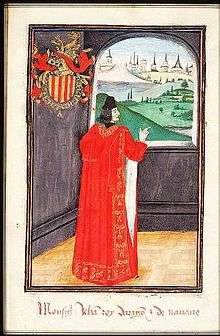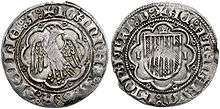John II of Aragon
John II (Catalan: Joan II, Aragonese: Chuan II and Basque: Joanes II), called the Great (el Gran) or the Faithless (el Sense Fe)(29 June 1398 – 20 January 1479),[1] was the King of Navarre through his wife (jure uxoris) from 1425 and the King of Aragon in his own right from 1458 until his death. He was the son of Ferdinand I[2] and his wife Eleanor of Alburquerque.[3] John was also King of Sicily from 1458-1468.
| John II | |
|---|---|
 John as a Knight of the Golden Fleece Miniature from the southern Netherlands, 1473 | |
| King of Aragon, Majorca, Valencia, and Sardinia Count of Barcelona | |
| Reign | 27 June 1458 – 20 January 1479 |
| Predecessor | Alfonso V |
| Successor | Ferdinand II |
| King of Sicily | |
| Reign | 1458 – 1468 |
| Predecessor | Alfonso |
| Successor | Ferdinand II |
| King of Navarre | |
| Reign | 8 September 1425 – 20 January 1479 |
| Predecessor | Blanche I |
| Successor | Eleanor |
| Co-monarch | Blanche I |
| Born | 29 June 1398 Medina del Campo |
| Died | 20 January 1479 (aged 80) Barcelona |
| Burial | |
| Consort | Blanche I of Navarre Juana Enríquez |
| Issue among others... | Charles IV of Navarre Blanche II of Navarre Eleanor I of Navarre Ferdinand II of Aragon Joanna, Queen of Naples (illeg.) Alfonso de Aragón (illeg.) Juan de Aragón |
| House | Trastámara |
| Father | Ferdinand I of Aragon |
| Mother | Eleanor of Alburquerque |
| Religion | Roman Catholicism |
Biography

John was born at Medina del Campo (in the Crown of Castile). In his youth he was one of the infantes (princes) of Aragon who took part in the dissensions of Castile during the minority and reign of John II. Till middle life he was also lieutenant-general in Aragon for his brother and predecessor Alfonso V, whose reign was mainly spent in Italy. In his old age he was engaged in incessant conflicts with his Aragonese and Catalan subjects, with Louis XI of France, and in preparing the way for the marriage of his son Ferdinand with Isabella I of Castile which brought about the union of the crowns of Aragon and Castile and which was to create the Kingdom of Spain. His troubles with his subjects were closely connected with tragic dissensions within his own family.
John was first married to Blanche I of Navarre of the house of Évreux. By right of Blanche he became king of Navarre, and on her death in 1441 he was left in possession of the kingdom for his lifetime. But one son, Charles, given the title "Prince of Viana" as heir of Navarre, had been born of the marriage. John quickly came to regard this son with jealousy. After his second marriage, to Juana Enríquez, it grew into absolute hatred, being encouraged by Juana. John tried to deprive his son of his constitutional right to act as lieutenant-general of Aragon during his father's absence. Charles's cause was taken up by the Aragonese, however, and the king's attempt to make his second wife lieutenant-general was set aside.
There followed the long Navarrese Civil War, with alternations of success and defeat, ending only with the death of the prince of Viana, perhaps by poison administered by his stepmother in 1461. The Catalans, who had adopted the cause of Charles and who had grievances of their own, called in a succession of foreign pretenders in a War against John II. His last years John spent contending with these. He was forced to pawn Roussillon, his possession on the north-east of the Pyrenees, to King Louis XI of France, who refused to part with it.
In his old age John was blinded by cataracts, but recovered his eyesight by the operation of couching conducted by his physician Abiathar Crescas, a Jew. The Catalan revolt was pacified in 1472, but John carried on a war, in which he was generally unfortunate, with his neighbor the French king till his death in 1479. He was succeeded by Ferdinand, his son by his second marriage, who was already married to Isabella I of Castile. With his death and son's accession to the throne of Aragon, the unification of Spain under one royal house began in earnest.
Marriages and issue
From his first marriage to Blanche of Navarre, John had the following children:
- King Charles IV of Navarre (1421–1461)
- Infanta Juana (1423 – 22 August 1425)
- Queen Blanche II of Navarre (1424–1464)
- Queen Eleanor of Navarre[4]
.jpg)
From his second marriage to Juana Enríquez, John had the following children:
- Ferdinand II of Aragon[4]
- Joanna of Aragon (1455–1517). Married Ferdinand I of Naples.
Illegitimate children:
- Alfonso de Aragón y de Escobar, Duke of Villahermosa
- Juan de Aragón (1440–1475), Archbishop of Zaragoza
- Felipe de Carrayos del Radona (Phillipe del Radona)
Ancestors
| Ancestors of John II of Aragon[5] | ||||||||||||||||||||||||||||||||||||||||||||||||||||||||||||||||||||||||||||||||||||||||||||||||||||||||||||||||||||||||||||||||||||||||||||||||||||||||||||||||||||||||||||||||||||||||||||||||||||||||||||||||||||||||||||||||||||||||||||||||||||||||||||||||||||||||||||||||||||||||||||||||||||||||||||||||||||||||||||||||||||||||||||||||||||||||||||||||||||||||||||||||||||||||||||||||||||||||||||||||||||||||||||||||||||||||||||||||||||||||||||||||||||||||||||||||||||||||||||||||||||||||||||||||||||||||||||||||||||||||||||||||||||||||||||||||||||||||||||||||||||||||||||||||||||||||||||||||
|---|---|---|---|---|---|---|---|---|---|---|---|---|---|---|---|---|---|---|---|---|---|---|---|---|---|---|---|---|---|---|---|---|---|---|---|---|---|---|---|---|---|---|---|---|---|---|---|---|---|---|---|---|---|---|---|---|---|---|---|---|---|---|---|---|---|---|---|---|---|---|---|---|---|---|---|---|---|---|---|---|---|---|---|---|---|---|---|---|---|---|---|---|---|---|---|---|---|---|---|---|---|---|---|---|---|---|---|---|---|---|---|---|---|---|---|---|---|---|---|---|---|---|---|---|---|---|---|---|---|---|---|---|---|---|---|---|---|---|---|---|---|---|---|---|---|---|---|---|---|---|---|---|---|---|---|---|---|---|---|---|---|---|---|---|---|---|---|---|---|---|---|---|---|---|---|---|---|---|---|---|---|---|---|---|---|---|---|---|---|---|---|---|---|---|---|---|---|---|---|---|---|---|---|---|---|---|---|---|---|---|---|---|---|---|---|---|---|---|---|---|---|---|---|---|---|---|---|---|---|---|---|---|---|---|---|---|---|---|---|---|---|---|---|---|---|---|---|---|---|---|---|---|---|---|---|---|---|---|---|---|---|---|---|---|---|---|---|---|---|---|---|---|---|---|---|---|---|---|---|---|---|---|---|---|---|---|---|---|---|---|---|---|---|---|---|---|---|---|---|---|---|---|---|---|---|---|---|---|---|---|---|---|---|---|---|---|---|---|---|---|---|---|---|---|---|---|---|---|---|---|---|---|---|---|---|---|---|---|---|---|---|---|---|---|---|---|---|---|---|---|---|---|---|---|---|---|---|---|---|---|---|---|---|---|---|---|---|---|---|---|---|---|---|---|---|---|---|---|---|---|---|---|---|---|---|---|---|---|---|---|---|---|---|---|---|---|---|---|---|---|---|---|---|---|---|---|---|---|---|---|---|---|---|---|---|---|---|---|---|---|---|---|---|---|---|---|---|---|---|---|---|---|---|---|---|---|---|---|---|---|---|---|---|---|---|---|---|---|---|---|---|---|---|---|---|---|---|---|---|---|---|---|---|---|---|---|---|---|---|---|---|---|---|---|---|---|---|---|---|---|---|---|---|---|---|---|---|---|---|---|---|---|---|---|---|---|---|---|---|---|---|---|---|---|---|---|---|---|---|---|---|---|---|---|---|---|---|---|---|---|---|---|---|---|---|---|---|---|---|---|---|---|---|---|---|---|---|---|---|---|---|---|---|---|---|---|---|---|---|---|---|---|---|---|---|---|---|---|---|---|---|---|---|---|---|---|---|---|---|---|---|---|---|---|---|---|---|---|---|---|---|---|---|---|---|---|---|---|---|---|---|---|
| ||||||||||||||||||||||||||||||||||||||||||||||||||||||||||||||||||||||||||||||||||||||||||||||||||||||||||||||||||||||||||||||||||||||||||||||||||||||||||||||||||||||||||||||||||||||||||||||||||||||||||||||||||||||||||||||||||||||||||||||||||||||||||||||||||||||||||||||||||||||||||||||||||||||||||||||||||||||||||||||||||||||||||||||||||||||||||||||||||||||||||||||||||||||||||||||||||||||||||||||||||||||||||||||||||||||||||||||||||||||||||||||||||||||||||||||||||||||||||||||||||||||||||||||||||||||||||||||||||||||||||||||||||||||||||||||||||||||||||||||||||||||||||||||||||||||||||||||||
References
- Ruiz 2007, p. ?.
- Woodacre 2013, p. 91.
- Earenfight 2015, p. 143.
- Merriman 1918, p. 61.
- de Sousa, Antonio Caetano (1735). Historia genealogica da casa real portugueza [Genealogical History of the Royal House of Portugal] (in Portuguese). 2. Lisboa Occidental. p. 497.
Sources
| Wikimedia Commons has media related to John II of Aragon. |
- Earenfight, Theresa (2015). "Trastamara Kings, Queens, and the Gender Dynamics of Monarchy". In Todesca, James (ed.). The Emergence of León-Castile c.1065-1500: Essays Presented to J.F. O'Callaghan. Ashgate. p. 141-160.CS1 maint: ref=harv (link)
- Merriman, Roger Bigelow (1918). The Rise of the Spanish Empire in the Old and in the New. Vol. 2. The Macmillan Company.CS1 maint: ref=harv (link)
- Ruiz, Teófilo F. (2007). Spain's centuries of crisis: 1300–1474. Wiley-Blackwell. ISBN 978-1-4051-2789-9.CS1 maint: ref=harv (link)
- Woodacre, Elena (2013). The Queens Regnant of Navarre: Succession, Politics, and Partnership, 1274–1512. Palgrave Macmillan.CS1 maint: ref=harv (link)
- Rivadeneyra. "Cronicas de los reyes de Castilla," Biblioteca de autores espanoles, vols. Ixvi, Ixviii. Madrid, 1845.
- Zurita, G. Anales de Aragon. Saragossa, 1610.
- Prescott W. H. History of the Reign of Ferdinand and Isabella. 1854.

John II of Aragon Born: 29 June 1397 Died: 20 January 1479 | ||
| Regnal titles | ||
|---|---|---|
| Preceded by Alfonso the Magnanimous |
King of Aragon, Valencia, Majorca, Sicily, Sardinia and Corsica; Count of Barcelona 1458–1479 |
Succeeded by Ferdinand the Catholic |
| Count of Roussillon and Cerdagne 1458–1462 |
Succeeded by Louis the Prudent | |
| Preceded by Charles III |
King of Navarre (jure uxoris) 1425–1441 with Blanche I |
Succeeded by Charles IV de jure |
| King of Navarre de facto withholding the crown from Charles IV and Blanche II 1441–1479 |
Succeeded by Eleanor | |
| Spanish nobility | ||
| Vacant Title last held by Martin of Aragon |
Duke of Montblanc 1415–1458 |
Succeeded by Ferdinand II of Aragon |
| Preceded by James II of Urgell |
Lord of Balaguer 1418–1458 | |
| Preceded by Hugh of Cardona |
Duke of Gandia 1433–1439 |
Succeeded by Charles of Viana |
.svg.png)
